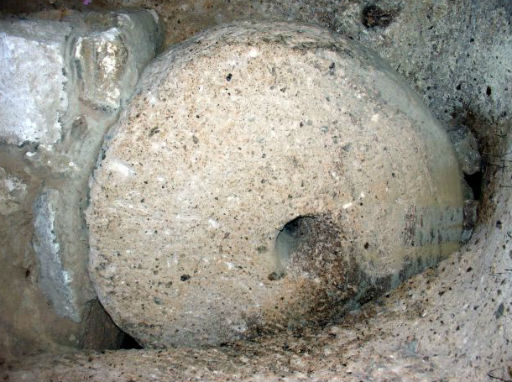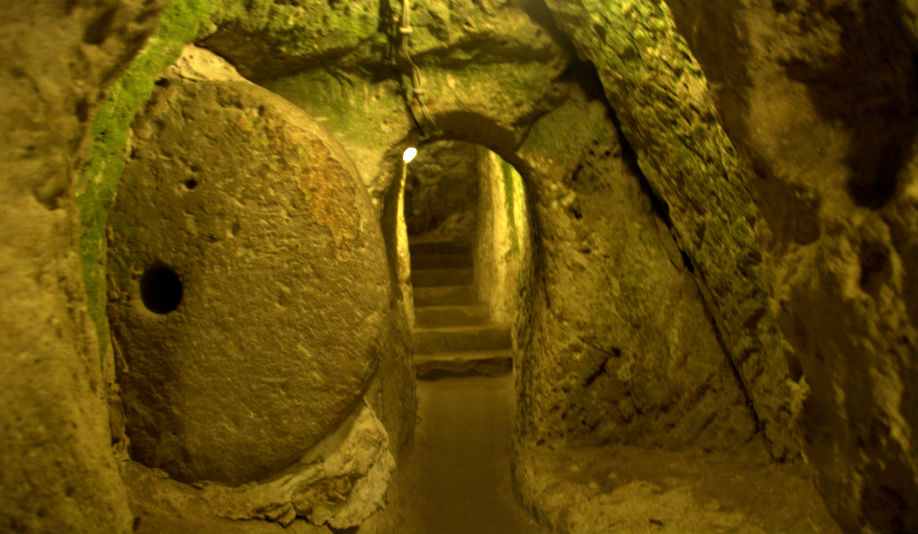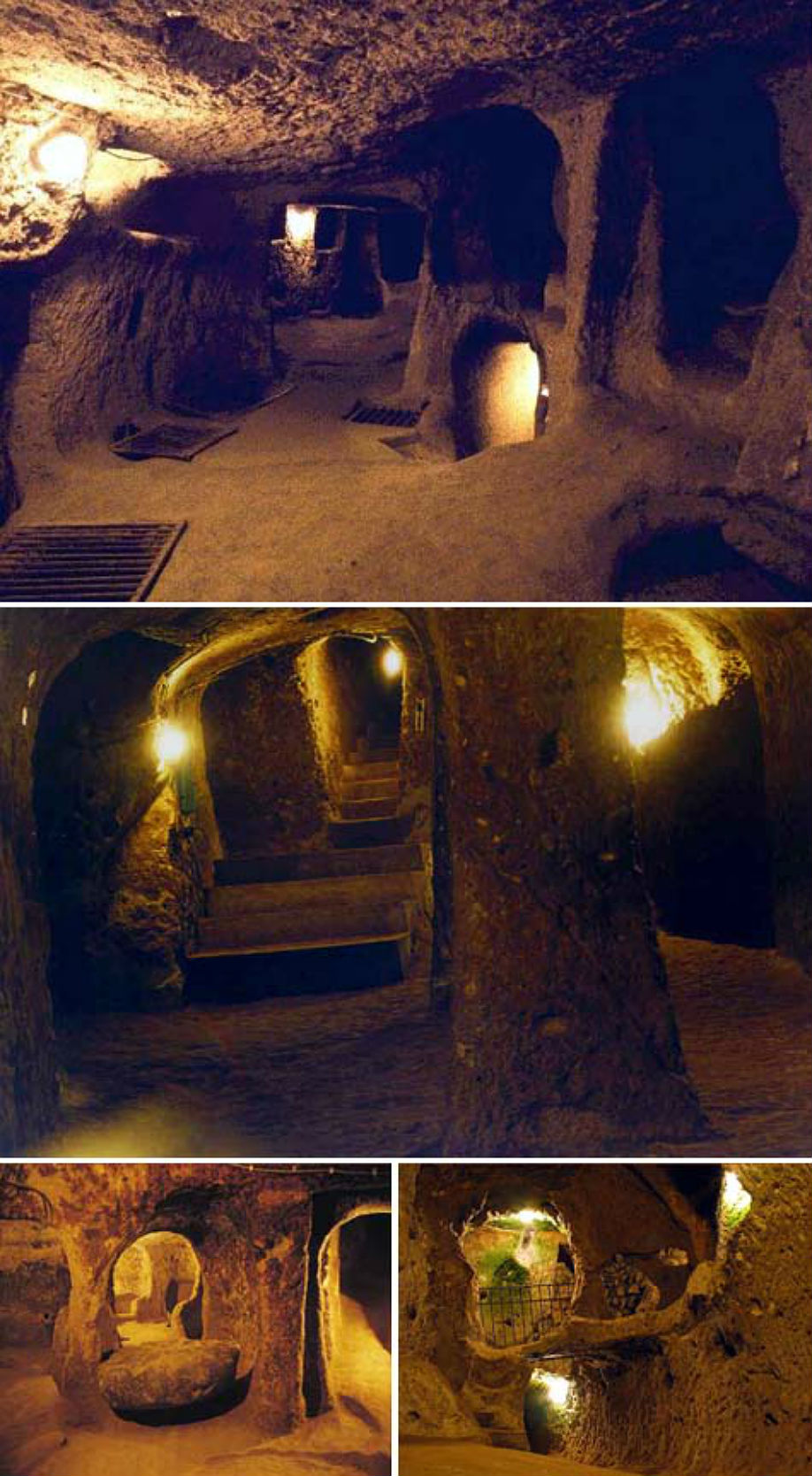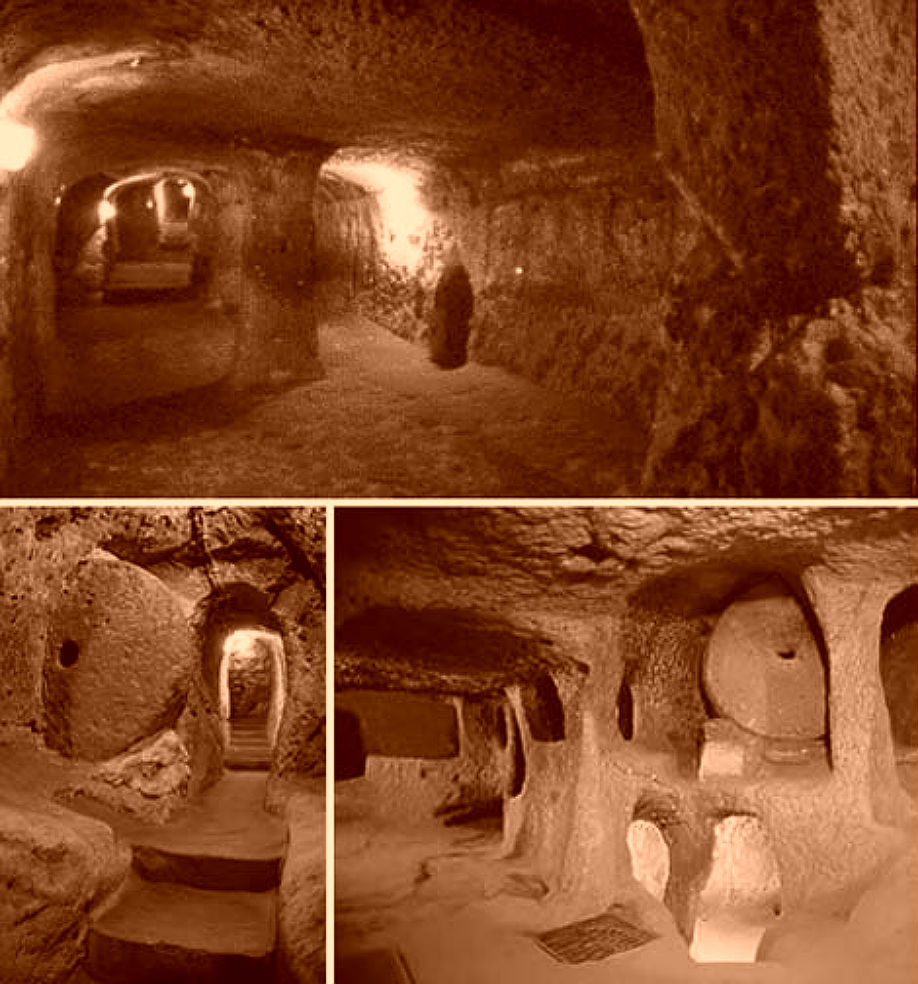Derinkuyu Underground City is an ancient multi-level underground city of the Median Empire in the Derinkuyu district in Nevşehir Province, Turkey.
Extending to a depth of approximately 60 m, it was large enough to shelter approximately 20,000 people together with their livestock and food stores.
It is the largest excavated underground city in Turkey and is one of several underground complexes found across Cappadocia.

One of the heavy stone doors. They have a height of 1–1,5 m, 30–50 cm in width and weigh 200–500 kg. The hole in the centre can be used to open or close the millstone, or to see who is outside.
It was opened to visitors in 1969 and to date, about half of the underground city is accessible to tourists. The underground city at Derinkuyu could be closed from the inside with large stone doors. Each floor could be closed off separately.
The city could accommodate up to 20,000 people and had all the usual amenities found in other underground complexes across Cappadocia, such as wine and oil presses, stables, cellars, storage rooms, refectories, and chapels. Unique to the Derinkuyu complex and located on the second floor is a spacious room with a barrel vaulted ceiling. It has been reported that this room was used as a religious school and the rooms to the left were studies.
Between the third and fourth levels is a vertical staircase. This passage way leads to a cruciform church on the lowest (fifth) level.
The large 55 m ventilation shaft appears to have been used as a well. The shaft also provided water to both the villagers above and, if the outside world was not accessible, to those in hiding.
History
First built in the soft volcanic rock of the Cappadocia region, possibly by the Phrygians in the 8th–7th centuries B.C according to the Turkish Department of Culture, the underground city at Derinkuyu may have been enlarged in the Byzantine era. During the Persian Achaemenid empire the city was used as a refugee settlement. There are references to underground refugee settlements built by the Persian king Yima in the second chapter of the Zoroastrian book Vendidad. Therefore many scholars believe that the city may have been built by the Persians. The city was connected with other underground cities through miles of tunnels.
Some artifacts discovered in these underground settlements belong to the Middle Byzantine Period, between the 5th and the 10th centuries A.D. It is speculated that the number of underground settlements, generally used for taking refuge and for religious purposes, increased during this era.
Derinkuyu Underground City, Cappadocia,





While Ephesus is fascinating, Pamukkale beautiful, and Perge both fascinating and beautiful, Urgup and the whole region of Cappadocia is in a category by itself. It is a jaw-dropping surprise as you come upon the unique geographic formations called fairy chimneys around the city. There are so many things to see near Urgup.
My favorite thing about Cappadocia was the bookstore that had a million used books from all the backpackers that had come through, all sorted by language, as well as quality. There was a section for “fiction” and another for “literature,” which only included books that didn’t suck. It was great.
I had always wanted to go to Cappadocia as I had been entranced by the photos of the cave dwellings built into volcanic ash cliff faces for decades, and had hoped to add a tour there to the end of my cruise which finished in Istanbul in July this year.
It was totaly impressive experience for us. It is 55 meters deep. If you haven't been in a such closed area before please think twice.
You can see domed structures that get higher towards the top of the rock as well as praying buildings, monks cave and shelters among the houses. They look like an ant colony looking from above. Saint Baptist Monastery, which is one of the oldest building in Cappadocia, is hidden among the rocks here. It is an enormous basilica carved in the top part of the rock. Cavusin Church is beside Goreme-Avanos road, 4 km far from Goreme.
First of all | would like to inform you if you are claustrophobic. but if not a must-to-SEE place. it is a hidden city for christians. it has 8 levels. kitchen living area etc. there are soo many things to explain..
Love every bit of this place. So fascinated by the historical bit of it , about how advanced the people in the past were. can't believe I felt so excited crawling through narrow dark tunnels.
Great place!! a must see. The underground city where people hid for days at a time. Many stories under the ground. The water cistern, ventilation shaft, praying chamber, kitchen, torture chamber, animal shed, stone doors-all well planned and laid out systematically.
Not recommended for the claustrophobic or very obese.
The Hittites built the first level and then over the centuries the Byzantines added another ten levels and expanded its width to approximately 4km all to escape religious prosecution. As other reviewers have mentioned it's not a place for those with respiratory or heart problems or for those that are claustrophobic. Some of the passages are quite small and require…
Derinkuyu Underground City was definitely a highlight. Most of the stuff has already been well covered by other reviewers. All I would say is that it's better to go in off peak seasons. There were no crowds and we basically has the whole place to ourselves, which adds to the authenticity and appreciation. I can just imagine what a pain…